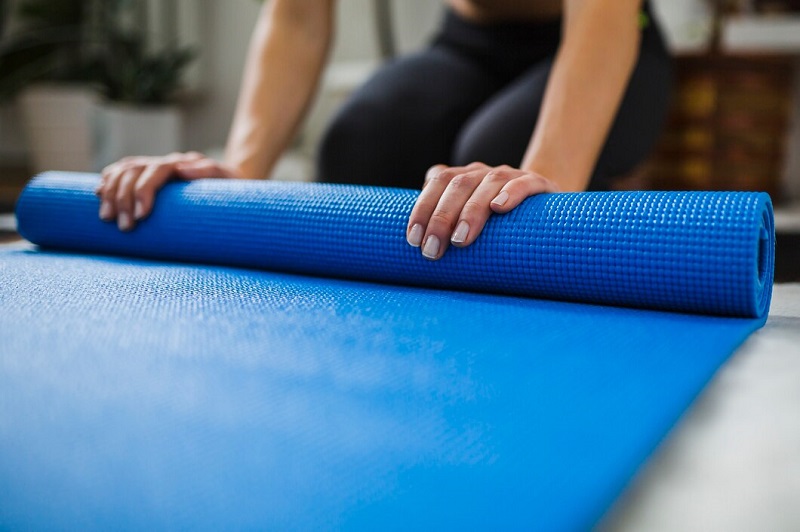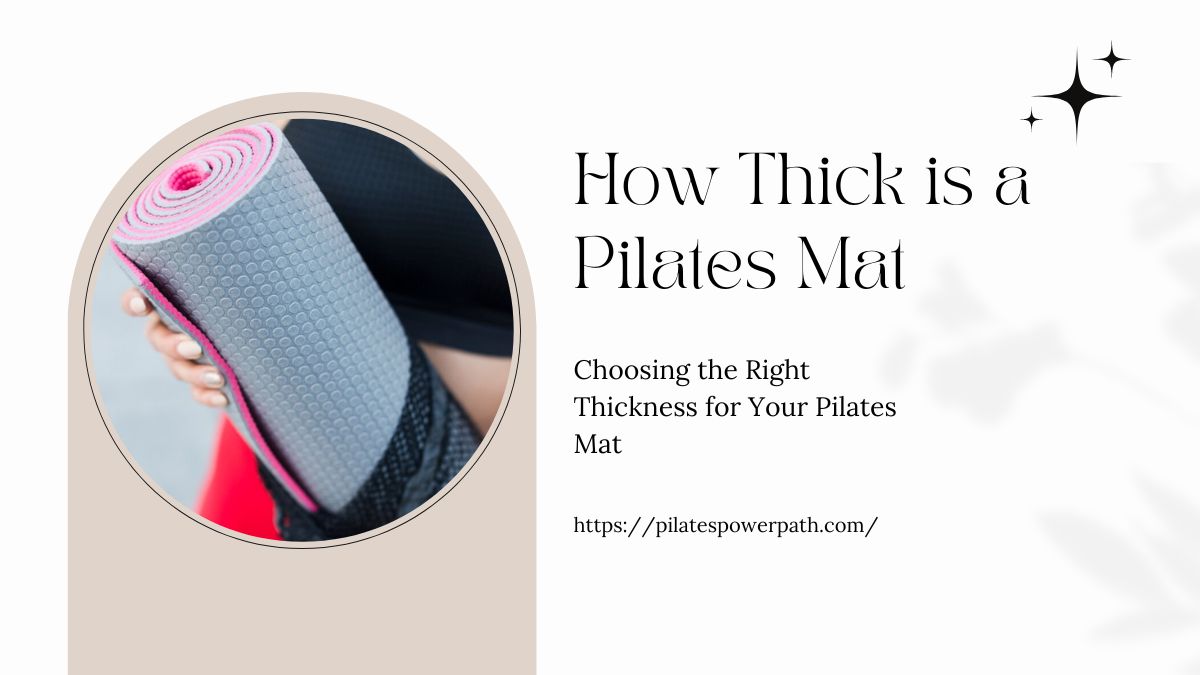Pilates, a physical fitness system developed in the early 20th century, has become a popular choice for many fitness enthusiasts. With its focus on flexibility, muscle strength, and endurance in the legs, abdomen, arms, hips, and back, it provides a comprehensive workout that promotes balanced muscle development and improves overall body fitness.
Pilates exercises often require minimal equipment, with a Pilates mat being one of the essential accessories practitioners need. The thickness of this mat can greatly influence the comfort and effectiveness of a Pilates workout. A thicker mat can provide better support for the spine and joints, making exercises more comfortable, especially when lying down or on the knees. On the other hand, a thinner mat can offer a more stable surface for balance-focused exercises. It’s all about finding the balance that suits your personal needs and ensures that your Pilates sessions are both comfortable and effective.
What is a Pilates Mat?
Definition and purpose of a Pilates mat in the practice.
A Pilates mat is a specific type of exercise mat used predominantly in Pilates workouts. Designed to cushion and support the body during exercises, it aims to enhance the comfort and effectiveness of Pilates routines. One key characteristic of a Pilates mat is its thickness; often denser than typical yoga mats, it provides the necessary support for the spine and joints. However, it’s essential to note that Pilates mats can vary in thickness, and choosing the right option depends on individual comfort and the types of exercises involved.
How it differs from yoga mats and other exercise mats.
Pilates mats differ from yoga mats and other exercise mats primarily due to their thickness and material. While yoga mats are usually thin and designed for better grip during standing poses, Pilates mats are typically thicker to provide more cushioning for rolling exercises and to protect the spine. The material of a Pilates mat is often denser and heavier than that of a yoga mat, providing improved stability for the variety of movements performed in a Pilates session.
Read More: Maximize Your Pilates Journey: A Comprehensive Guide
Importance of Mat Thickness in Pilates
Discuss the significance of mat thickness in terms of comfort and support during exercises.
The thickness of a Pilates mat plays a crucial role in the overall Pilates experience. It not only determines the level of comfort during exercises but also provides the necessary support for performing various movements.
Impact on joint cushioning and body alignment.
Adequate mat thickness is vital for two main reasons: joint cushioning and body alignment. Pilates exercises often involve movements that put pressure on the joints, especially the knees, elbows, and wrists. A sufficiently thick mat can provide the necessary cushioning to these joints, reducing the risk of discomfort or injury.
Moreover, proper body alignment is central to Pilates practice. A thick, supportive mat can help maintain proper posture and alignment during exercises, reducing the strain on the back and neck.
How different thicknesses cater to various needs of practitioners (e.g., beginners vs. advanced, different body types).
Different mat thicknesses cater to the diverse needs of practitioners. For instance, beginners or individuals with joint issues may benefit from a thicker mat, which provides extra cushioning and support. On the other hand, advanced practitioners or those focusing on balance exercises might prefer a thinner mat for more stability and ground feedback.
Regardless of one’s proficiency level, personal comfort should always be the guiding factor in choosing the right mat thickness. Just remember, that a mat that is too thin can cause discomfort, while one that is too thick may hinder balance and stability. Therefore, it’s crucial to find that ‘just right’ thickness that provides sufficient support without compromising on stability.

Standard Thickness of Pilates Mats
The marketplace offers a variety of Pilates mats with varying degrees of thickness, typically ranging between 3mm to 15mm. The choice of thickness largely depends on personal comfort, the type of exercise, and the individual’s physical condition.
Explaining the usual range of thicknesses available in the market (e.g., 3mm, 5mm, 8mm).
3mm Mats
A 3mm mat, often the standard thickness for yoga mats, may be used by some Pilates practitioners. These mats provide closer contact with the floor, offering better balance and stability, making them suitable for balance-focused exercises. However, they offer minimal cushioning, which may not be comfortable for everyone, especially when performing exercises that put pressure on the spine or joints.
5mm – 10mm Mats
Mats falling within this range offer a balance between comfort and stability. They provide better cushioning compared to a 3mm mat, making them more comfortable for exercises that require lying down or kneeling. However, they may not offer the same level of stability as a thinner mat. These mats are typically a good choice for beginners or those with joint concerns.
12mm – 15mm Mats
The thickest Pilates mats provide maximum cushioning and are often recommended for individuals with joint issues or those who prefer extra support and comfort. While these mats are excellent for cushioning the body, they are less stable than thinner options, making balance-focused exercises more challenging.
Regardless of thickness, all Pilates mats should have a smooth but non-slip surface to allow for safe and efficient movement during workouts. Ultimately, the choice of mat thickness should align with your physical needs and the type of Pilates exercises you plan to perform. Always prioritize your comfort and safety when choosing a Pilates mat.
Factors to Consider When Choosing Mat Thickness
Body Weight and Impact on Choosing the Appropriate Thickness
The practitioner’s body weight plays a significant role in selecting the correct mat thickness. Heavier individuals may require a thicker mat to provide adequate cushioning and support during exercises. Conversely, lighter individuals might find a thinner mat sufficient for their needs. It’s important to ensure that when lying down on the mat, your body does not touch the floor through the mat. If it does, consider opting for a thicker mat.
Individual Comfort Preferences and Exercise Intensity
Individual comfort preferences should be a determining factor when choosing a mat. Some individuals prefer the feel of a thick mat, while others might find a thinner mat more comfortable. Similarly, the intensity of the exercises you plan to perform can influence the mat thickness needed. High-intensity workouts may require a thicker mat for extra cushioning during more vigorous exercises, while low-intensity workouts might only need a thinner mat.
Mat Portability and Storage Considerations Based on Thickness
Finally, the thickness of a Pilates mat can affect its portability and storage. Thicker mats are heavier and bulkier, making them less portable and requiring more storage space. On the other hand, thinner mats are lighter and more compact, making them ideal for those who travel frequently or have limited storage space. Consequently, if you’re planning to carry your mat to and from class or store it in a small space, a thinner mat may be a more practical choice.

Expert Recommendations and Insights
Insights from Pilates instructors or fitness experts on the importance of mat thickness.
Pilates instructors and fitness experts often emphasize the importance of mat thickness in facilitating a safe and effective workout. They argue that choosing the right mat can significantly enhance one’s Pilates experience, contributing not only to physical comfort but also to the correct execution of exercises.
Tips for beginners in selecting the right mat thickness.
For beginners, experts usually recommend starting with a thicker mat (around 10mm) to provide ample cushioning and comfort as they familiarize themselves with the exercises. As practitioners become more advanced and their bodies adapt to the exercises, they may choose to transition to a thinner mat for improved stability and proprioceptive feedback.
Additional Considerations
In addition, experts recommend testing different mat thicknesses before making a purchase. This can be done at a local fitness store or at a Pilates studio, where different types of mats are usually available for trial. Remember, the right mat for you should feel comfortable, provide appropriate support, and suit your specific workout preferences and needs. Finally, always keep in mind that while the mat is an important piece of equipment, it is just one factor in your overall Pilates experience. Regular practice, proper technique, and listening to your body are equally, if not more, important for a successful and enjoyable Pilates journey.
Conclusion
In conclusion, choosing the right thickness for a Pilates mat is a crucial part of enhancing your workout experience. The choice is largely personal and will depend on several variables such as your body weight, your comfort preferences, the intensity of your exercises, and your storage and portability needs. Experts recommend beginners start with a thicker mat for extra cushioning and gradually move to a thinner mat as they gain more control and stability. It’s worth trying out different thicknesses to identify what suits you best. Just remember, while the mat is an essential accessory, the core of a rewarding Pilates experience lies in regular practice, good technique, and being attuned to your body’s signals.
Frequently Asked Questions
For beginners, experts often recommend starting with a thicker mat, typically around 10mm. This provides greater cushioning and comfort as they get accustomed to the exercises. As they gain proficiency and their bodies adapt, they might transition to a thinner mat for better stability and feedback.
Body weight has a significant role in selecting the appropriate mat thickness. Heavier individuals might need a thicker mat for adequate cushioning and support during exercises. Lighter individuals, on the other hand, might find a thinner mat sufficient. The key is not to have the body touch the floor through the mat during exercises, which might call for a thicker mat.
Yes, the thickness of a Pilates mat can influence its portability and storage. Thicker mats are heavier and bulkier, making them less portable and requiring more storage space. Conversely, thinner mats are lighter and more compact, making them a practical choice for those who travel frequently or have limited storage space.




